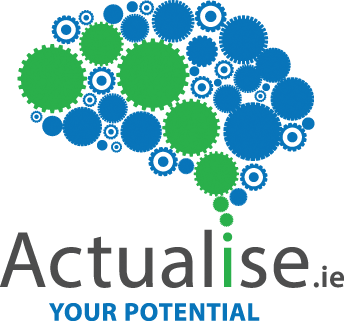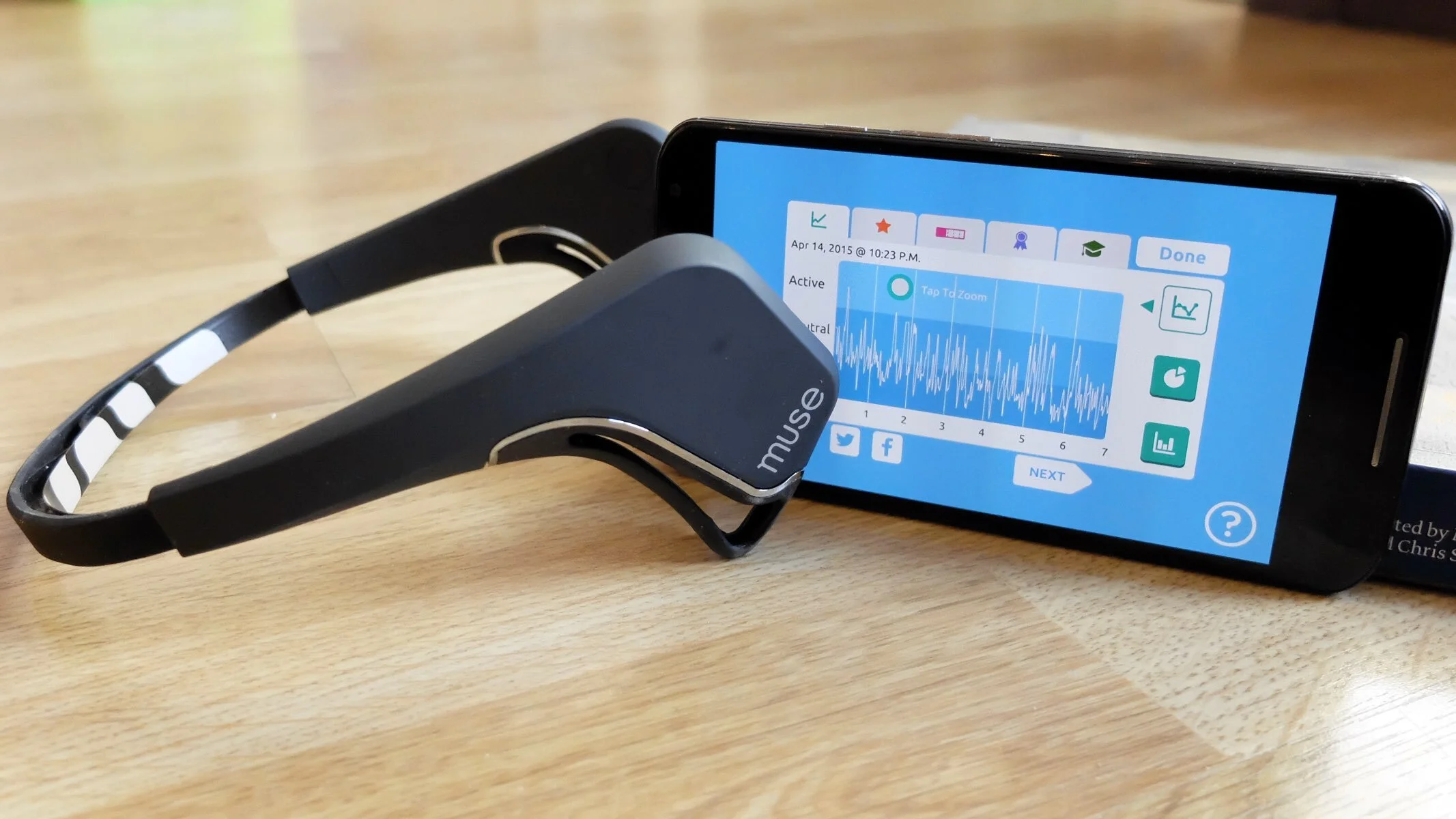Why Muse? Validation Research on the Use of the Muse Headband for Neurofeedback Purposes
The Muse headset and app
Since its first introduction in the market, the Muse headband has had a significant impact on the neurofeedback community, offering practitioners a new exciting way to provide their services, treating their clients remotely from the comfort of their homes.
Originally created with the goal to revolutionize guided meditation, and key component of the home neurofeedback platform we use at Actualise, the Muse headband is a compact 7+1-channel electroencephalography (EEG) system that leverages advances in dry sensor technology, Bluetooth and digital signal processing, with recent studies demonstrating its applicability and reliability both inside and outside the laboratory.
For example, a randomized control trial showed improved performance in a Stroop test and greater levels of emotional wellbeing in healthy adults who meditated for 10 min daily over a period of 6 weeks using the Muse headband running under the original neurofeedback set up, when compared with age and gender matched controls who were instead required to take an online math training daily.
Interestingly, in the study, increased levels of attention as measured by general (in both congruent and non-congruent conditions) reaction time did not predict increased levels of wellbeing, conversely to other meditation training programs aimed at developing mindful attention in daily life.
However, many studies employing mindfulness meditation have been criticized for their methodological limitations, which make it more difficult to elucidate underlying mechanisms. Also, they typically require the participant’s engagement for much longer time, which may increase the likelihood for dropouts especially in clinical populations with reduced motivation.
Other research supports the ability of Muse meditation to induce significant effects on baseline electroencephalogram (EEG) activity in non-controlled environments.
In particular, a data driven study by Kovacevic et al. (2015) on 523 healthy volunteers who were required to meditate in naturalistic conditions (i.e. on a stage during a public event) using the Muse headband integrated into an ad hoc purposed brain computer interface (BCI) system, demonstrated the ability of a “relaxation vs concentration” protocol to reliably and durably modulate alpha or beta activity, respectively (See figure below).
(A ) Mean relative spectral power (RSP) curves across 8 guided conditions in alpha and beta frequency band range.
(B) Left: mean scores for main effect of “relaxation vs. concentration” across the 1–50 Hz frequency range. Right: frequency pattern of main effect.
Remarkably, participants received less than 7 min neurofeedback sessions, which is much shorter than any standard session and other data in the same study showed that participants could learn to modulate their relative spectral power within only 60s (alpha, in a solo relaxation protocol) or 80s (beta, in a solo concentration protocol) training periods.
More recent findings suggests the use of Muse in clinical setting. More specifically a study with traumatized youth found that a Muse-based intervention improved post-traumatic symptoms, reliably improving physiological stress regulation as derived from respiratory sinus arrhythmia (RSA) and decreasing self-rated anxiety levels in all participants.
Importantly, none of the participants who played with Muse dropped out of the study, suggesting remarkably greater acceptability when compared to other game-based or traditional trauma-focused interventions . These results suggest that more research should explore the ability of Muse to modulate EEG anomalies in populations with emotional disorders, including generalized anxiety disorder and depression, given that a number of neurofeedback studies employing higher density caps have demonstrated to induce beneficial effects.
Finally a controlled study on a small group of children with attention deficit hyperactivity disorder (ADHD) found that children who engaged in theta/beta neurofeedback training three to four times a week for 9 weeks exhibited significant improvement in attention, distraction inhibition and hyperactivity when compared to children who did not receive any treatment during the 9-week period.
These results may be in line with previous neurofeedback research with ADHD children linking improved neuroregulation to changes in the theta/beta ratio mainly driven by the decrease of generalised theta activity, putatively associated with Hebbian learning-based neuroplastic remodeling in the brain.
Importantly, these findings also confirm the ability of short-term neurofeedback training to induce ameliorating effects in children with ADHD, which is more likely to decrease dropout rates and reduce treatment costs altogether. Follow up randomised trials in a larger cohort of subjects are certainly needed to confirm these findings and further establish the treatment protocol employed in this pilot study.
At Actualise, we use Muse to deliver customised home neurofeedback protocols in combination with a platform that enables our practitioners to monitor the client’s results and progress remotely. Talk to us today to learn more about our treatment packages.
References
1. Bhayee S, Tomaszewski P, Lee DH, Moffat G, Pino L, Moreno S, et al. Attentional and affective consequences of technology supported mindfulness training: a randomised, active control, efficacy trial. BMC Psychol. 2016;4(1):60.
2. Wolkin JR. Cultivating multiple aspects of attention through mindfulness meditation accounts for psychological well-being through decreased rumination. Psychol Res Behav Manag. 2015;8:171-80.
3. Chiesa A, Serretti A. A systematic review of neurobiological and clinical features of mindfulness meditations. Psychol Med. 2010;40(8):1239-52.
4. Lutz A, Slagter HA, Dunne JD, Davidson RJ. Attention regulation and monitoring in meditation. Trends Cogn Sci. 2008;12(4):163-9.
5. Kovacevic N, Ritter P, Tays W, Moreno S, McIntosh AR. 'My Virtual Dream': Collective Neurofeedback in an Immersive Art Environment. PLoS One. 2015;10(7):e0130129.
6. Gruzelier J, Bamidis P, Babiloni F, de Ridder D. Applied Neuroscience: models, methods, theories, reviews. Neurosci Biobehav Rev. 2014;44:1-3.
7. Schuurmans AAT, Nijhof KS, Scholte R, Popma A, Otten R. A novel approach to improve stress regulation among traumatized youth in residential care: Feasibility study testing three game-based meditation interventions. Early Interv Psychiatry. 2019.
8. Boyd JE, Lanius RA, McKinnon MC. Mindfulness-based treatments for posttraumatic stress disorder: a review of the treatment literature and neurobiological evidence. J Psychiatry Neurosci. 2017;42(6):170021.
9. Hammond DC. Neurofeedback with anxiety and affective disorders. Child Adolesc Psychiatr Clin N Am. 2005;14(1):105-23, vii.
10. Doniger GM, Kaddan, A.,. Efficacy Study in Children with Attention-Deficit/Hyperactivity Disorder (ADHD). International Society for Neurofeedback and Research (ISNR) Denver (USA)2019.


